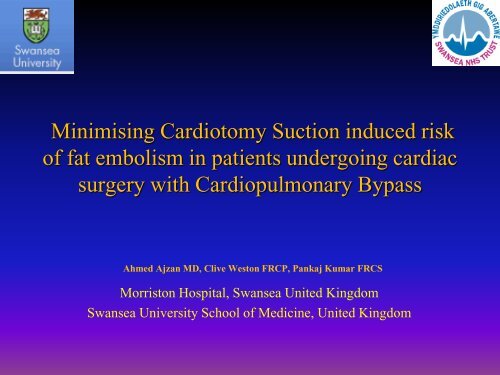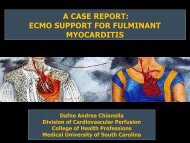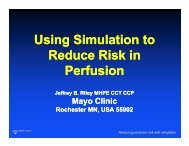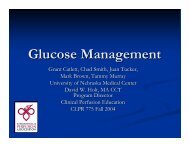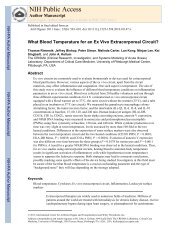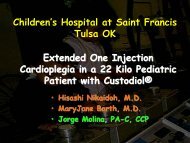PowerPoint Presentation (PDF) - Perfusion.com
PowerPoint Presentation (PDF) - Perfusion.com
PowerPoint Presentation (PDF) - Perfusion.com
You also want an ePaper? Increase the reach of your titles
YUMPU automatically turns print PDFs into web optimized ePapers that Google loves.
Minimising Cardiotomy Suction induced risk<br />
of fat embolism in patients undergoing cardiac<br />
surgery with Cardiopulmonary Bypass<br />
Ahmed Ajzan MD, Clive Weston FRCP, Pankaj Kumar FRCS<br />
Morriston Hospital, Swansea United Kingdom<br />
Swansea University School of Medicine, United Kingdom
Declaration<br />
This study was funded by Astra ® Sweden without<br />
input into sampling, randomisation or the research<br />
data
Complications of CPB<br />
• Neurological/Neuropsychological dysfunction with CPB<br />
• Stroke at 20% in 1973, 8% in 1982 and 3% in 1995<br />
• Neuropsychological dysfunction recognised in up to 50%<br />
• Study of 46 brain tissues of patients who died after cardiac<br />
surgery with CPB showed only 9 had normal brain tissue<br />
Brierley JB . Brain damage <strong>com</strong>plicating open heart surgery: a neuropathological study of<br />
46 patients. Proc.R.Soc.Med . 1967 :60(9):858-9
Studies in the incidence of Neurological and<br />
Neuropsychological deficit<br />
Author Year Incidence of<br />
Neurological<br />
deficit<br />
Sontaniemi 1983 39%<br />
Breuer 1983 17%<br />
Carrella 1988 48%<br />
Strenge 1992 51%<br />
Murkin 1995 38%
•Diffused brain damage (type II injury) Ranging from visual field<br />
defects to hyper-reflexia to more long term persistent neurological<br />
deficits that involve intellectual and cognitive functions without<br />
localizing or focal signs that are attributed to the CPB<br />
Van Dijk D, Keizer AM, Diephuis JC, Durand C, Vos LJ, Hijman R. Neurocognetive dysfunction after coronary<br />
artery bypass surgery: a systematic review. J Cardiovasc Surg.2000;120:632-9<br />
•Pericardial Suction Blood (PSB) used to recycle blood during<br />
cardiac surgery with cardiopulmonary bypass is a major source of<br />
fat re-introduction<br />
Caguin F, Carter MG. Fat embolisation with cardiotomy with the use of cardiopulmonary bypass. J Cardiovasc<br />
Surg.1963;46:665-72
3 Major causes of Cerebral injury During<br />
cardiac surgery with CBP<br />
• Global or regional cerebral hypoperfusion<br />
• Macroemboli<br />
• Microemboli<br />
Moody DM, Bell MA, Challa VR, Johnston WE, Prough DS. Brain microemboli during cardiac surgery or<br />
aortography. Ann Neurol.1990;28:477-86
Macroemboli<br />
• Large air bubbles<br />
• Atheromatous debris from valve lesions or aortic plaques<br />
• Intracardiac thrombi<br />
• fat emboli<br />
• Aortic instrumentation<br />
• Excessive surgical manipulation<br />
• size ; > 40 um
Causes of Microemboli<br />
• Air<br />
• Gaseous<br />
• Lipid globules<br />
• Muscle and connective tissue fragments<br />
• Platelets and Leukocyte aggregates<br />
• plastic fragments<br />
• calcified particles<br />
• size ; < 40 um
Microemboli<br />
• Stump and colleagues studied<br />
CABG patients reported, the<br />
number and size emboli<br />
detected via Doppler methods is<br />
directly proportional to the<br />
degree of Neuropsychological<br />
dysfunction .<br />
Okies JE, Goodnight SH, Litchford B, Connel RS,<br />
Starr A et al. Effects of cardiotomy suction<br />
blood extracorporial circulation for coronary<br />
artery bypass surgery. J Thorac Cardiovasc<br />
Surg.1977;74(3):440-4
• It has been feasible to quantify the fat being<br />
generated and mobilised during routine cardiac<br />
surgery with cardiopulmonary bypass and<br />
establish that the current filtration systems are<br />
unable to deal with the generated fat<br />
Ajzan A, Modine T, Punjabi P, Ganeshalingam K, Philips G, Gourlay T et al.<br />
Quantification of fat mobilization in patients undergoing coronary artery<br />
Revascularization using off-pump and on-pump techniques. Extra Corpor Technol. 2006<br />
Jun;38(2):122.
During cardiac surgery fat is<br />
generated and mobilised via<br />
the surgical procedure and<br />
surgical manipulation and can<br />
be re-admitted into the<br />
circulation.<br />
Fat can be measured<br />
biochemically analysed and<br />
<strong>com</strong>pared in a particular<br />
patient or between different<br />
patients.<br />
Existing Filtration methods<br />
are unable to deal with<br />
circulating fat Emboli
Count/dl<br />
counts/dl<br />
2950<br />
Embolic Load of the CABG group<br />
2450<br />
Mid-Bypass Suction<br />
Mid-Bypass Arteial<br />
5900<br />
4900<br />
3900<br />
2900<br />
1900<br />
1950<br />
1450<br />
950<br />
Mid-Bypass Venous<br />
End-Bypass Suction<br />
End-Bypass Arterial<br />
End-Bypass Venous<br />
900<br />
-100<br />
Pre-Op Mid-Bypass End-Bypass<br />
Bypass Time (min)<br />
Suction Arterial Venous<br />
450<br />
-50<br />
0-10 m 10-15 m 15-20 m > 20 m<br />
Size<br />
Ajzan et al
PLAN OF STUDY AND AIMS<br />
To evaluate the effectiveness of a fat filtration<br />
device in minimising the fat emboli mobilised via<br />
the cardiotomy suction during cardiopulmonary<br />
bypass.<br />
Study Design<br />
Prospective Randomised Trial<br />
Consecutive isolated CABG cases (aged 18-80, No<br />
emergencies)
MATERIALS AND METHODS<br />
•Study approved by Ethics & Research <strong>com</strong>mittees<br />
•Randomisation via number generator<br />
•Investigator blinded to randomisation & not part of the<br />
surgical team<br />
Single surgical team was to minimise technical variations<br />
•50 consecutive patients (n=50) were consented and<br />
randomised for this study<br />
•25 patients (n=25) had a fat reducing system installed to the<br />
cardiotomy suction line of the CPB and 25 patients (n=25) had<br />
no system installed.
Sampling sites<br />
•Cadiotomy suction vs.<br />
Cardiotomy suction after<br />
the filter<br />
•Arterial line<br />
•Venous line<br />
At :<br />
•Start of bypass time<br />
•Mid bypass<br />
•End of bypass before<br />
<strong>com</strong>ing off
Fat Reducing System<br />
•soft shell reservoir with<br />
two <strong>com</strong>partments each<br />
able to house 500mls of<br />
cardiotomy suction blood,<br />
separated by a water lock<br />
mechanism<br />
•the filter is manufactured<br />
using uncoated standard<br />
PVC materials identical to<br />
that used in venous<br />
reservoirs<br />
•Appelblad M, Engström KG. Fat<br />
content in pericardial suction blood<br />
and the efficacy of spontaneous density<br />
separation and surface adsorption in a<br />
prototype system for fat reduction .J<br />
Thorac Cardiovasc Surg. 2007<br />
Aug;134(2):366-72..
•Oil Red O stain 1-[4-<br />
(Xylylazo)]-2-<br />
naphthol;solvent red<br />
27 to stain the fat<br />
globules<br />
•size estimation is<br />
established using<br />
microspheres (dyetrack,<br />
Triton<br />
technologies,UK)<br />
(6MILLION/2MLS)(1<br />
5U in size)(violet)
Results
Patient Demographic and surgical data<br />
Filtered Group Non-Filtered Group p value<br />
Mean SD Mean SD<br />
Age 68.56 7.74 66.2 7.14 0.14<br />
Sex(males) 74% 76%<br />
Height(cm) 171.61 7.79 170.23 7.42 0.5274<br />
Weight(Kg) 80.6 8.7 79.2 8.23 0.562<br />
Body Surface Area (m2) 2.03 0.74 1.99 0.68 0.843<br />
No. of Grafts 2.8 0.96 3.12 0.86 0.2205<br />
Euroscore 2.56 1.41 2.48 1.44 0.8435<br />
Surgery Time 120.84 24.66 126.84 11.73 0.2774<br />
CPB Time(min) 87.6 22.6 84.88 29.21 0.55<br />
Cross Clamp Time(min) 55.24 19.4 53.48 20.81 0.65<br />
Cardiotomy shed Blood(mls) 309.72 55 327.44 43 0.2105
• we identified that Embolic load to the<br />
patient during cardiopulmonary bypass is<br />
reflected by the number of fat emboli<br />
greater than 15um that detected arterial line<br />
cannula which pose greater risk to the<br />
patient<br />
• Venous Sample results:<br />
No statistically significant differences were<br />
found in venous samples in both groups at<br />
CPB sampling points
Venous Line Samples
Cardiotomy suction Samples
2500<br />
2000<br />
P < 0.001<br />
1416<br />
count/dl<br />
1500<br />
P < 0.001<br />
1000<br />
P = 0.1001<br />
698<br />
500<br />
335.64<br />
273.32<br />
330 342<br />
0<br />
start of bypass mid bypass end of bypass<br />
filtered group<br />
non-filtered group
Arterial Line Samples
140<br />
120<br />
Mean Embolic Load Counts/dl<br />
p< 0.001<br />
100<br />
p = 0.0209<br />
104.68<br />
80<br />
60<br />
p = 0.646<br />
66<br />
40<br />
35.48<br />
32.56<br />
46.72<br />
50.52<br />
20<br />
0<br />
start of bypass mid bypass end bypass<br />
non filtered<br />
filtered
140<br />
120<br />
Mean Embolic Load Counts/dl<br />
p< 0.001<br />
100<br />
p = 0.0209<br />
104.68<br />
80<br />
60<br />
p = 0.646<br />
66<br />
40<br />
35.48<br />
32.56<br />
46.72<br />
50.52<br />
20<br />
0<br />
start of bypass mid bypass end bypass<br />
non filtered<br />
filtered
Filtered Group<br />
(n=25)<br />
Non-Filtered Group (n=25)<br />
p value<br />
Start of Bypass suction 273.32 +/- 123.34 335.64 +/- 130.60 0.1001<br />
arterial 32.56 +/- 22.14 35.48 +/- 23.97 0.646<br />
Mid Bypass suction 330.0 +/- 119.60) 698.0 +/- 250.61 < 0.001<br />
arterial 46.72 +/- 27.30 46.72 +/- 27.30 0.0209<br />
End of Bypass suction 342.0 +/- 98.26 1416 +/- 485.76 < 0.001<br />
arterial 50.52 +/- 28.47 104.68 +/- 35.87 < 0.001
Conclusion
•we demonstrated in a randomised trial that<br />
fat being generated and mobilised during<br />
cardiac revascularisation with<br />
cardiopulmonary bypass CPB can be<br />
reduced using Fat reducing Systems and<br />
that such reduction can be calculated and<br />
measured at different time intervals during<br />
bypass achieving more than 50% reduction<br />
in Embolic load to the patient in the group<br />
where these systems are used
Study Limitations<br />
•We Acknowledge that the longer the bypass time, the more Fat<br />
Emboli will be generated and mobilised in the cardiopulmonary<br />
bypass circuit<br />
•Longer bypass times and testing this system on more <strong>com</strong>plex cases<br />
including valvular surgery and open chamber surgeries will be<br />
beneficial<br />
•Clinical observations in the form of neuro-psychometric analysis or<br />
fundoscopy in future continuation of this study will help in<br />
demonstrating clinical out<strong>com</strong>e in using these systems
Our goal
• References<br />
• Gibbon JH Jr.: The development of the heart-lung apparatus. Rev Surg., 1970;(4):231-44<br />
• Becerius J, Gummert JF, Borger MA, Walther T, Doll N, Onnasch JF, et al. Stroke after cardiac<br />
surgery: a risk factor analysis of 16184 consecutive adult patients. Ann Thorac Surg.2003;<br />
75:472-8.<br />
• Newman MF, Krrchner JL, Phillips-Bute B, Gaver V, Grocott H, Jones RH, et al. Neurological<br />
out<strong>com</strong>e Research group and cardiothoracic Anesthesiology research Endeavours<br />
Investigators. Longitudinal assessment of neurocognetive function after coronary artery<br />
bypasses surgery. N Engl J Med.2001;344:395-402<br />
• Van Dijk D, Keizer AM, Diephuis JC, Durand C, Vos LJ, Hijman R. Neurocognetive dysfunction<br />
after coronary artery bypass surgery: a systematic review. J Cardiovasc Surg.2000;120:632-9<br />
• Moody DM, Bell MA, Challa VR, Johnston WE, Prough DS. Brain microemboli during cardiac<br />
surgery or aortography. Ann Neurol.1990;28:477-86<br />
• Caguin F, Carter MG. Fat embolisation with cardiotomy with the use of cardiopulmonary<br />
bypass. J Cardiovasc Surg.1963;46:665-72<br />
• Brooker RF, Brown WR, Moody DM, Hammon JW,Reboussin DM, Deal DD et al. Cardiotomy<br />
suction: a major source of brain lipid emboli during cardiopulmonary bypass .Ann Thorac Surg.<br />
1998:65 1651-5<br />
• Ajzan A, Modine T, Punjabi P, Ganeshalingam K, Philips G, Gourlay T et al. Quantification of fat<br />
mobilization in patients undergoing coronary artery Revascularization using off-pump and onpump<br />
techniques. Extra Corpor Technol. 2006 Jun;38(2):122.<br />
• Okies JE, Goodnight SH, Litchford B, Connel RS, Starr A et al. Effects of cardiotomy suction<br />
blood extracorporial circulation for coronary artery bypass surgery. J Thorac Cardiovasc<br />
Surg.1977;74(3):440-4<br />
• Appelblad M, Engström KG. Fat content in pericardial suction blood and the efficacy of<br />
spontaneous density separation and surface adsorption in a prototype system for fat<br />
reduction .J Thorac Cardiovasc Surg. 2007 Aug;134(2):366-72..<br />
• Brierley JB . Brain damage <strong>com</strong>plicating open heart surgery: a neuropathological study of 46<br />
patients. Proc.R.Soc.Med . 1967 :60(9):858-9<br />
• Appelblad M, Engström KG. Fat reduction in pericardial suction blood by spontaneous density<br />
separation: an experimental model on human liquid fat versus soya oil. <strong>Perfusion</strong>. 2003<br />
Mar;18(1):39-45.<br />
•<br />
•
Thank you


